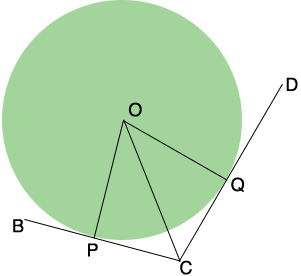| |||
| Math Central | Quandaries & Queries |
|
Question from Lalitesh, a student: A circle is inscribed in a regular hexagon ABCDEF |
Hi Lalitesh,
If the hexagon is regular then all the sides are of equal length and the result is obvious. I think the problem should say
"A circle is inscribed in a hexagon $ABCDEF$. Prove that $AB+CD+EF=BC+DE+FA.$"
I drew a diagram of the inscribed circle and two of the sides of the hexagon, $BC$ and $CD.$

In my diagram $P$ and $Q$ are the points of tangency and $O$ is the center of the circle. Since $OQ$ is a radius of the circle and $CD$ is tangent to the circle angle $CQO$ is a right angle. Similarly angle $OPC$ is a right angle. What can you say about the length of $PC$ and $CQ?$
Penny
 |
||
Math Central is supported by the University of Regina and the Imperial Oil Foundation.